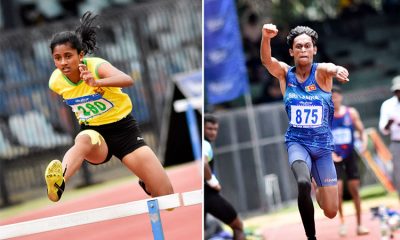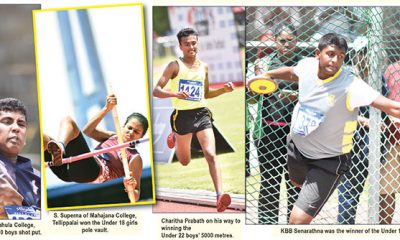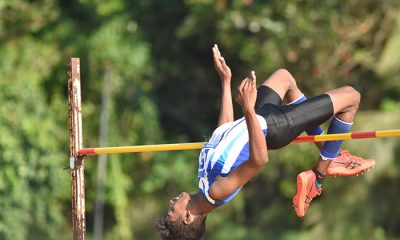Sports
Nethmika accomplishes rare feat, breaks national junior record
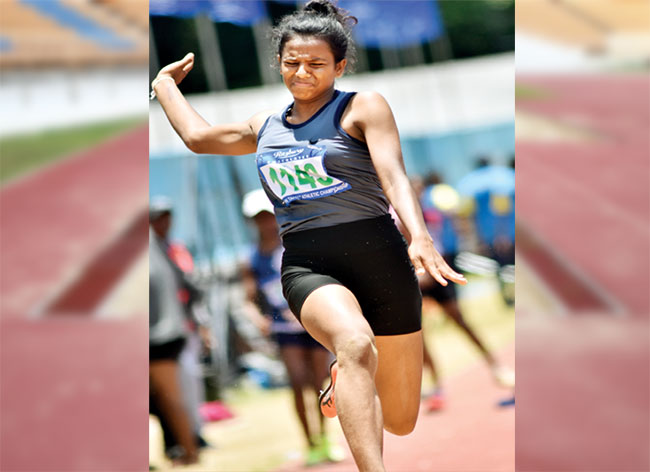
By Reemus Fernando
Long jumper Nethmika Madushani Herath accomplished a rare achievement at the Sir John Tarbat Senior Athletics Championships which concluded at Diyagama on Friday. The athlete from Nannapurawa MV, Bibile has produced impressive performances at every national level competition since early last year. But what she achieved last week was beyond doubt the most outstanding feat as she shattered the National Junior Long Jump record established in 2017.
Her 6.09 metres jump shattered three records. First it was Ridma Nishadi’s 2016 meet record (6.02 metres). Then it was also the National Junior record (6.08m) which Nishadi had established in 2017. Sri Lanka Athletics has recognized it as both the National Youth and the National Junior record.
What makes her achievement more impressive is her age. Nethmika is 17 years old and is in the youth category (U18). She will enter the junior category next year.
Coached by her school’s Physical Training Instructor Krishantha Kumara, Nethmika has emerged as Sri Lanka’s brightest prospect at next month’s Asian Youth Championships as her performance is set to rank among the top two feats in the Under 18 age category in Asia.
Nethmika commenced the year with a feat of 5.76 metres in February and improved to 5.98 metres when she shattered another meet record at the Junior National Championships in April. That was the best feat in Asia by April this year.
Later several athletes in Asia improved on that feat. Currently there are three other athletes who have cleared the six metres barrier in her age category in Asia. The World Athletics statistics show China’s Huicong Shen and Japanese duo Koto Matsumura and Ion Kondo as having cleared the six metres mark.
Nethmika’s 6.09 is only second to Kondo’s 6.13 metres in Asia this year.
Though she has proven beyond doubt that she is a clear future prospect it is doubtful whether she could get the necessary support from country’s sports authorities. She has received the support of Sri Lanka Athletics but at present even some of country’s top national athletes who are closer to achieving Asian Games qualifying standards remain unaided as Sports Ministry is slow to act and is in fund saving mode.
Latest News
Head and Smith centuries grind England in the SCG dirt

Travis Head departed the SCG field to a thunderous ovation after his latest demolition of England in this Ashes series. But the roars from the terraces soon deafened when Usman Khawaja walked to the crease in his final Test match.
After Head’s belligerent 163 off 166 balls, his third century in what has been a remarkable series, Khawaja – batting at No.6 – could not produce a fairytale innings against a flagging England attack in the Sydney sunshine.
In what might prove to be his final Test innings, Khawaja fell for 17 in an ungainly dismissal – a low full-toss from Brydon Carse – and left the ground to more hearty applause.
Skipper Steven Smith then stole the show for the remainder of day three with an unbeaten 129 off 205 balls to put Australia in a commanding position as they seek a convincing 4-1 series victory.
Australia appear to have broken England’s spirit in an innings stretching 124 overs. Their first-innings lead has ballooned to 134 runs and looks particularly significant with uneven bounce becoming notable and cracks set to widen amid warm weather in Sydney.
Smith wasn’t at his most fluent, but looked locked in from the get go with his usual theatrics at the crease on full display. He even at one point asked Carse at mid-off to put his sunglasses on the back of his hat due to the reflection.
Smith feasted on wayward England bowling and also made a point to be aggressive against spinners Will Jacks and Jacob Bethell. A 37th Test century and 13th against England almost felt inevitable as he ended a relatively lean series in style, kissing his helmet in celebration late in the day.
Smith moved into second all-time on the Ashes run scorers and century list, with only Sir Donald Bradman ahead on both fronts.
His first home Ashes hundred since the 2017-18 series has tightened Australia’s grip on the match. They were aided by shabby bowling and fielding from England, who dropped four catches in the first session with Smith being reprieved on 12 by Zak Crawley at leg-slip just before lunch.
The early part of the day was dominated by Head, who had only just fallen short of scoring a century in an elongated final session on day two, but it didn’t take him long to reach his 12th Test ton.
After resuming on 91, Head completed his 105-ball century just 25 minutes into the day’s play and he celebrated by sticking his helmet on top of his bat handle as he once again had the crowd in the palm of his hands.
It ended Head’s modest record at the SCG as he became the fifth player to score tons at seven different venues in Australia.
Head received strong support from Michael Neser, who was used wisely as the nightwatcher ahead of Scott Boland after the latter performed the role in the previous Test.
Neser showed off his batting credentials, having made 4000 career runs in first-class cricket with five centuries. He frustrated England with solid defence and the occasional boundary to grind down the beleaguered tourists.
Head continued his rampant form from the previous afternoon when he inflicted more pain on hapless seamer Maththew Potts, whose Ashes debut has turned into a nightmare.
A new day did not bring an improved showing with Potts immediately smashed for three consecutive fours by a ruthless Head. England continued to persist with short-ball plans, even to Neser, and it almost paid off when Head skied Carse to deep midwicket only for Jacks to drop a sitter, taking his eyes off the ball as he was seemingly worried about the nearby boundary cushion.
Not only did it prove costly for England, Jacks had the further ignominy of receiving mocked cheers from the Australian fans when he subsequently fielded.
Head in the next over had another lucky escape when Carse dropped a much tougher chance at deep third but it only left Potts feeling even more aggrieved.
For all their focus on hitting a shorter length, Carse finally dislodged Neser with a superb outswinger that was caught behind to end the 72-run partnership.
Potts’ century was brought up when Head launched him into the crowd as England’s miserable session continued. Head did attempt to settle himself down having not quite recaptured his formidable batting from the previous day while Smith started in scratchy fashion.
Capping a forgettable morning for England, Smith was dropped at leg-slip by Crawley in a sharp chance down to his left to deny Josh Tongue another wicket against the Australia captain. Jacks’ woes continued when he could not hang on to a bullet from Head that was rifled back to him in the final over before lunch.
Head eyed a maiden double century but his hoodoo of getting out between 150-175 continued shortly after the interval when he missed a premeditated sweep and fell lbw to Bethell with his review proving unsuccessful.
After letting Head get his moment in the sun as he acknowledged the fans, Khawaja stepped onto the field amid a loud ovation but the game then went through a rare lull this series.
Khawaja and Smith played watchfully, with Ben Stokes pushing his battered body in a lionhearted spell with the old ball. Having been the most consistent and threatening bowler of an inexperienced attack, it was curious that Stokes decided not to have a breather until the second new ball.
Having sprayed the ball to start the innings, Potts and Carse were thrown the second new ball too, which did offer some swing as Australia closed in on England’s first innings total.
Khawaja made just 10 off his first 40 deliveries before briefly winding back the clock with a gorgeous drive down the ground off Potts. England once again appeared to be unravelling with Carse curiously bowling over the wicket despite Khawaja’s last 12 dismissals to right-arm pace being from around the wicket.
But Khawaja missed a full toss from Carse and then unwisely decided to review with ball-tracking confirming it was smashing the bottom of the middle stump. The crowd again rose, but there was no big wave of the bat for Khawaja and time will tell if he bats again in his Test career.
Alex Carey looked in glorious touch before on 16 glancing Tongue to leg-slip – the third time in four innings he has fallen in that manner. Cameron Green, batting at No.8, entered under enormous pressure having found himself being unable to convert starts and repeatedly falling in unusual ways.
Green started well with a glorious drive then pulled Stokes into the crowd as he moved to 37 in good time. But the critics will again be lining up after Green threw it away when he spooned a short Carse delivery straight to deep square leg.
Beau Webster, often competing with Green for a spot in the team, looked composed on his Ashes debut as he and Smith ensured England’s tired bowlers will have to back up for a third consecutive day.
Brief scores:
Australia 518 for 7 in 124 overs ( Travis Head 163, Marnus Labuschagne 48, Steven Smith 129*; Brydon Carse 3-108, Ben Stokes 2-87) lead England 384 in 97.3 overs (Joe Root 160, Harry Brook 84, Jamie Smith 46; Mitchell Starc 2-93, Michael Neser 4-60, Scott Boland 2-85) by 134 runs
[Cricinfo]
Latest News
Bangladesh bans IPL broadcast over Mustafizur row

The Bangladesh government has banned the broadcast of IPL 2026 in the country as a response to the BCCI’s decision to pull Mustafizur Rahman out of the tournament.
A statement from the ministry of information and broadcasting said that it had “noted that no reason was communicated for the decision behind Mustafizur Rahman’s exclusion [from the IPL]” and that the development had “caused distress among the people of Bangladesh”. The decision had been taken “in public interest”, it said.
The statement was signed by the ministry’s assistant secretary Firoz Khan.
TV channels and streaming platforms have broadcast the IPL in Bangladesh since its inception in 2008. This is also the first time that the Bangladesh government has banned the telecast of an international cricket tournament, anywhere in the world.
On Saturday, Kolkata Knight Riders (KKR), the team that bought Mustafizur at the IPL auction in December, released him following instructions from the BCCI. The BCCI did not specify a reason – its secretary Devajit Saikia mentioned “recent developments” and did not elaborate.
Over the past few days, Indian spiritual and political leaders had criticised KKR and their owner Shah Rukh Khan for including Mustafizur in their line-up at a time when, according to reports, Hindu minorities are being attacked in Bangladesh. Relations between the two countries have deteriorated since.
Bangladesh are already petitioning the ICC to shift their T20 World Cup matches out of India. No decision has been made on that front yet. The original schedule has Bangladesh opening their campaign against West Indies at Eden Gardens in Kolkata on February 7.
Dr Asif Nazrul, who is currently the sports adviser to the Bangladesh government, said on Saturday evening that the IPL shouldn’t be shown in Bangladesh. Following that post on social media, the country’s information adviser Syeda Rizwana Hasan said any decision to stop broadcasting IPL in Bangladesh would be taken after reviewing the legal basis and thoroughly examining the relevant procedures.
Later on Sunday evening, the BCB confirmed that it has written to the ICC seeking relocation of Bangladesh’s T20 World Cup matches from India, likely to Sri Lanka, the other hosts of the tournament. They have reportedly also written to the BCCI seeking an explanation about Mustafizur’s withdrawal.
While there has been an unspoken ban in the IPL on players from Pakistan for many years now, several Bangladesh players have taken part in the tournament. Mustafizur was the only one picked by a team for the upcoming season, and has been an IPL regular since 2016, with Shakib Al Hasan (KKR and Sunrisers Hyderabad) the other prominent import from the country. Both of them have experience winning the title too.
Abdur Razzak (Royal Challengers Bengaluru), Mohammad Ashraful (Mumbai Indians), Mashrafe Mortaza (KKR), Tamim Iqbal (the now-defunct Pune Warriors India) and Litton Das (KKR) are the others from Bangladesh who have been a part of the IPL in previous years. The new season begins on March 26.
(Cricinfo)
Sports
Rehan scores century as Royal amass 347 against Petes
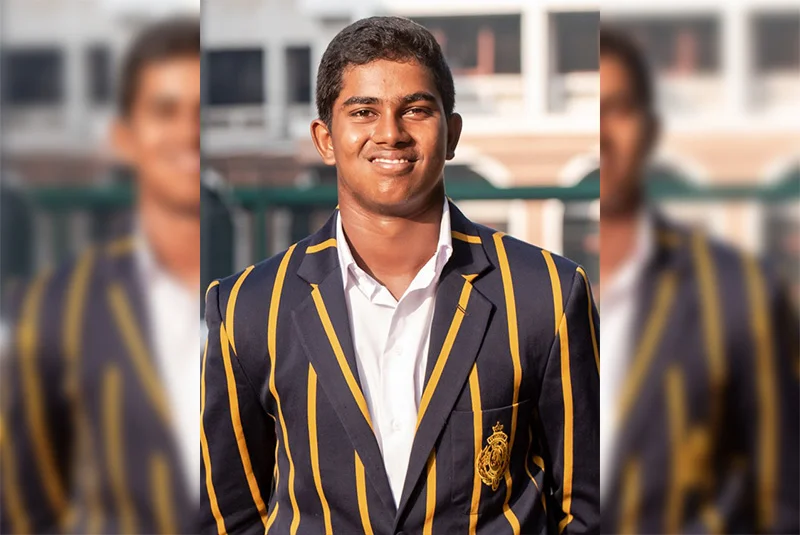
Under 19 Cricket
Rehan Peiris produced his best batting performance of the season, a valuable 125, as Royal amassed 347 against St. Peter’s on day one of the Under 19 Division I tier ‘A’ match at Bambalapitiya on Monday.
At Asgiriya, Mahanama bowlers produced a dominant performance against Trinity.
Trinity were six wickets down for 43 runs at one stage before Praveen Mithila and Santhosh Kritheekshan made vital contributions for them to post 153 runs.
While five half centuries powered St. Joseph’s to 344 runs against St. Sebastians’ at Moratuwa, Nalanda struggled to post 226 against Prince of Wales at Campbell Place as Nadul Aponso picked up six wickets for the visitors.
Day one Scores
Royal 347, St. Peter’s 54/2 at Bambalapitiya
Scores
Royal 347 all out in 80 overs (Rehan Peiris 125, Thevindu Wewalwala 20, Manuth Dasanayake 71, Himaru Deshan 58; Thenura Dissanayake 2/74, Janith Panditharathne 6/103)
St. Peter’s
54 for 2 in 10 overs (Sehandu Sooriyaarachchi 2/07)
Mahanama bowlers dominate at Asgiriya
Scores
Trinity
153 all out in 52.3 overs (Praveen Mithila 47, Santhosh Kritheekshan 34; Geeth Sandaruwan 3/33, Thenuja Rashmin 3/35, Venura Kaveethra 2/34)
Mahanama
5 for 1 in six overs
Nadul’s six wickets restrict Nalanda at Campbell Place
Scores
Nalanda 226 all out in 79 overs (Nadul Jayalath 25, Santhul Wijerathna 46, Nemindu Akmeemana 27, Osanda Pamuditha 66, Dunitha Anusara 40; Nadul Aponso 6/53, Nethul Anuhas 4/67)
Prince of Wales
50 for no loss in 16 overs (Palingu Perera 24n.o., Suwas Fernando 25n.o.)
Five half centuries proppel Joes to 344 at Moratuwa
Scores
St. Joseph’s
344 all out in 79.1 overs (Yenula Danthanarayana 74, Aveesha Samash 52, Rishma Amarasinghe 90, Chethina Kavinda 70, Dilpa Ruwanaka 28; Koshendra Fernando 5/115, Shenash Hashein3/51, Navinu Fernando2/65)
St. Sebastians’ 37 for 3 in 13 overs (Nushan Perera 2/06)
by Reemus Fernando
-
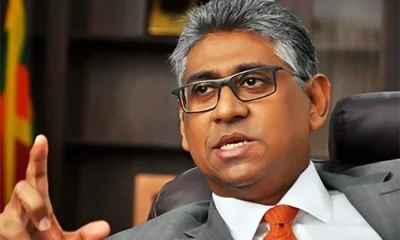
 News12 hours ago
News12 hours agoBroad support emerges for Faiszer’s sweeping proposals on long- delayed divorce and personal law reforms
-

 News1 day ago
News1 day agoPrivate airline crew member nabbed with contraband gold
-

 News3 days ago
News3 days agoHealth Minister sends letter of demand for one billion rupees in damages
-

 Opinion5 days ago
Opinion5 days agoRemembering Douglas Devananda on New Year’s Day 2026
-
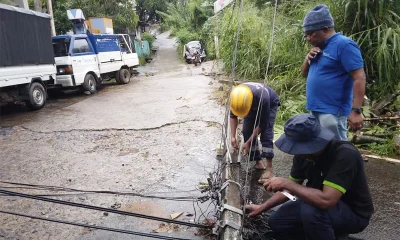
 News6 days ago
News6 days agoLeading the Nation’s Connectivity Recovery Amid Unprecedented Challenges
-

 Features1 day ago
Features1 day agoPharmaceuticals, deaths, and work ethics
-

 Latest News1 day ago
Latest News1 day agoCurran, bowlers lead Desert Vipers to maiden ILT20 title
-

 News1 day ago
News1 day agoPM lays foundation stone for seven-storey Sadaham Mandiraya


